We moved to Ubud yesterday. As we drove into town, the constant juxtaposition of the ancient and modern worlds of Bali increased exponentially. To my left, out the car window, I saw the “ice cream woman.” She was on a scooter with a cooler full of ice cream strapped to the back of her seat with plastic tie cords. Hanging from the cooler were individually wrapped ice cream wafer cones dangling in vertical rows from the top. We were passing through a village famous for wood carving. There were many shops full of beautiful handmade wooden objects and furniture. I watched a man sitting on the ground, honing a wooden sculpture, all with hand tools. Next door was an auto repair machine shop, and two blocks down the road, a tattoo parlor, advertising tattoos in angular black and white letters. A four-year-old boy stood in the front of his mother on a scooter, wearing Spiderman clothes. Then we passed a sleek, expensive art gallery with a big Mastercard/Visa card on the side. All within two blocks.
We were stuck in traffic. I could see laundry handing on a broken bamboo rack next to a shack, right near a three way intersection jammed with scooters and air-conditioned vans shuttling eager tourists into the city. We passed yoga stores, restaurants of every stripe, ice cream parlors, and a sign that read, “Say no to drugs. Say yes to tacos.” I caught a glimpse of hookahs at a burger bar.
Later: Our group is now spread across three hotels in a two-block radius. Karyn and I have a lovely room perched on the edge of stunning rice field.
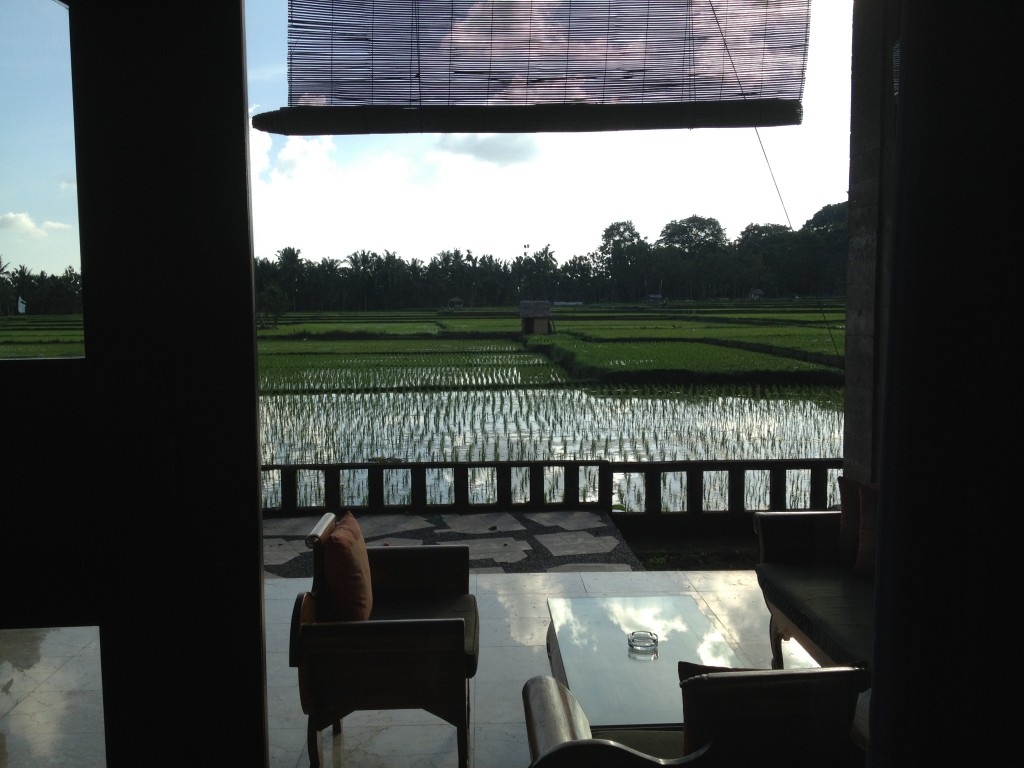
We gathered in the parking lot of our hotel at six this morning for a writing excursion to the local morning market. As we waited for everyone to arrive, excited work spread through our group about the Supreme Court’s gay marriage ruling. We have no wifi in our rooms, so I haven’t been surfing the web, so this was the first I’d heard about it. People’s voices were high and excited, chatting about the implications, and how surprised they were that the walls have really come down, now, at this point in history.
We piled into the vans, and fifteen minutes later, we tumbled out into the parking lot of the morning market where Balinese women buy their food for the day—as well as makings of the offerings you see everywhere.
Before we spread out, I repeated my instructions, asking everyone to leave their cameras in the vans—reiterating that this was a writing-only excursion. I asked people to take their small notebooks and to find a perch and just observe the activities and transactions that were taking place and to jot down what they saw, even if they couldn’t understand it.
Here are some of the things I saw, painted in words:
- A row of plastic boxes of limes, folded green leaves, shallots, galangal, and tiny red and green chili.
- A hundred green bananas in bunches, their tips pointing toward the sky.
- A large stack of multi-colored bras—teal, pink, black, pink, white and blue striped, with cups far larger than the breasts of any Balinese woman I’ve seen.
- A man selling Spiderman, Hello Kitty, and Disney Princess Mylar balloons, along with other cheap plastic crap, all wrapped in plastic. The whole bamboo display rack was attached to the back of his scooter, dwarfing it completely. The body of his bike was painted a psychedelic yellow, purple, red, blue and white. An ancient weathered brown leather jacket was tossed haphazardly over the handlebars.
- Two plucked chickens lie on a table, their heads facing each other, their legs pointing straight up into the air.
- An ancient red scale has small weights on a flat platform on one side and a large gold metal basin for weighing meat in the other. A woman hacks unidentifiable cuts of meat with a worn cleaver on a round wooden board, and puts purchases in plastic bags and then takes the bills with her bloody hands.
Here’s a place I sat for fifteen minutes:
- A woman sits on a wooden bench behind a pile of pre-made offering baskets tied up in yellow plastic bags. She reaches behind her into a pink mesh plastic basket for a piece of green plant material. She quickly takes a leaf and with quick practiced precision, cuts the long stiff leaf and expertly fashions it into a woven basket. She reaches into a black and white striped plastic bag and pulls out some green moss and fills the basket she has made. She reaches into a second bag and tops the moss with light blue flower blossoms. Soon, red petals and marigolds join the blue flowers. Each basket gets its quotient of measured beauty. Scraps of leaves litter the ground beneath her feet.
And I sat here watching for twenty:
- Across from me, a table holds three plastic buckets, each with a small amount of brightly colored liquid in the bottom. One looks the color of vanilla pudding with small lumps (like large pearl tapioca?) floating it. The middle bucket has liquid the color of raspberry Kool-Aid, and the one on the far left is clumpy and green. There is a second row of plastic buckets behind the first, but from my perch I cannot see them. The seller wears a tight red long-sleeve Danskin-type shirt, v-neck with her breasts clearly defined. When customers come, she reaches a small florescent green ladle into a number of the buckets and takes a small amount from each and pours it into a plastic bag, about the size of the bags you get when you buy a lone goldfish at a pet store. She makes several of these goldfish bags full of a mixture that reminds me, a mystified and somewhat horrified interloper, of the concoctions my friend Mindy and I made in my mother’s kitchen when we were eight: a little Worcestershire sauce, some milk, green food coloring, a dash of Tabasco, and a pinch of brown sugar. Then we’d challenge each other to drink it. Now an older Balinese woman orders a glass of this concoction and hands over a few well-worn bills to pay for it. Smiling, the seller ladles the ingredients into a glass, stirs it with a long metal spoon. As the customer drinks it, I hear the sharp whine of a dog in pain while another small dog, looking as if he’s never been loved a day in his life, barks restlessly hoping for a scrap of food or attention.
After our market outing we all went out to breakfast at the Three Monkeys, a delicious restaurant in central Ubud. They obviously weren’t used to parties our size; they only had eight breakfast menus in the entire place, so all 19 of us had to share. As we waited for our food, I had all the writers get in groups of three and share the observations they had written. That was our writing class for the day.
The Three Monkeys was a study in contrasts. As the Girl from Impanema played on the stereo, and we ate eggs Florentine, carrot-beet juice, and a wide range of elegant, beautifully displayed modern café food, I only had to turn my head 90 degrees to look immediately behind my side of the table to a rice field. I looked past the remnants of my French press chai to watch a barefoot man wearing a straw hat systematically use a huge squeegee, the size of a large push broom, scraping and smoothing the top of the muddy, watery surface of the paddy, working over the same area over and over again. He must have been standing 20 yards away from me.

As I watching him, sunk in mud up to his calves, I could hear three conversations going on in my vicinity: more animated discussion about the lifting of the gay marriage ban, two women discussing animism, and a third explaining soul collage cards. The tablecloth in front of me was littered with the remains of fancy water bottles and elegant cups of salt, pepper and sugar. As we waited for our check, a thin Balinese woman, wearing a sarong and a temple scarf carried a basket of offerings, delivering each, with prayers, incense, and reverence to the altars in our area of the restaurant, as well as placing several on the ground right near me to satiate the ground deities.

As we struggled to figure out who owed what in our bill (which totaled 1,461,650.00 rupiah for a dozen of us), we slowly accrued a huge pile of purple, red, green, and blue bills. After Karyn and I paid our share, I turned back to the rice field with a slight turn of my head, to see the workers in the field planting the very new tender green rice starts in the newly tilled paddy.
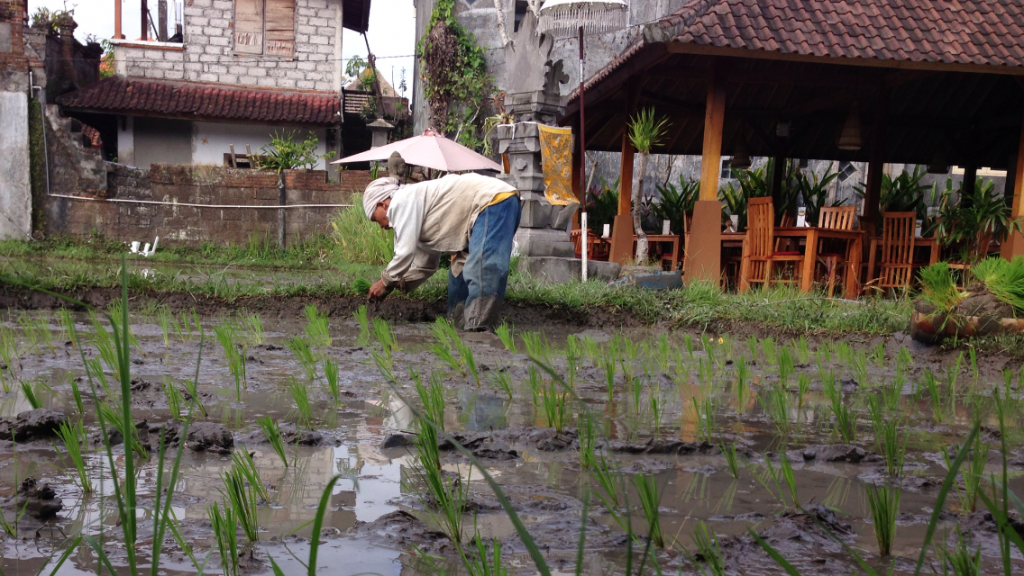
After breakfast, most of our group went with Judy on a walking tour of the monkey forest, and the surrounding areas, but Karyn and I had done it last year, so we decided to amble on our own. With a vague plan to head toward the art museum, we made a left out the door of the restaurant and immediately encountered this:
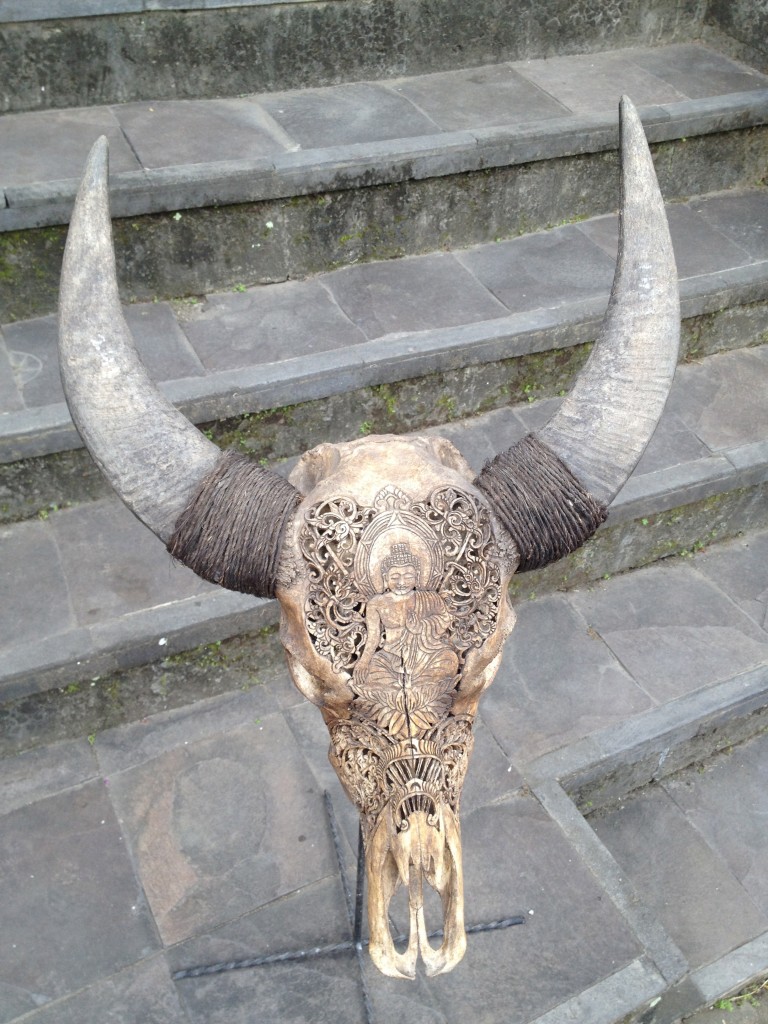
Two doors down, we came across this shopkeeper, Aju Juli, standing in front of a Sagitarius Collection, a typical tourist shop, full of sarongs, baskets, colorful sandals and metal statuary. She was just starting to create a beautiful flower arrangement on the entryway to her store:
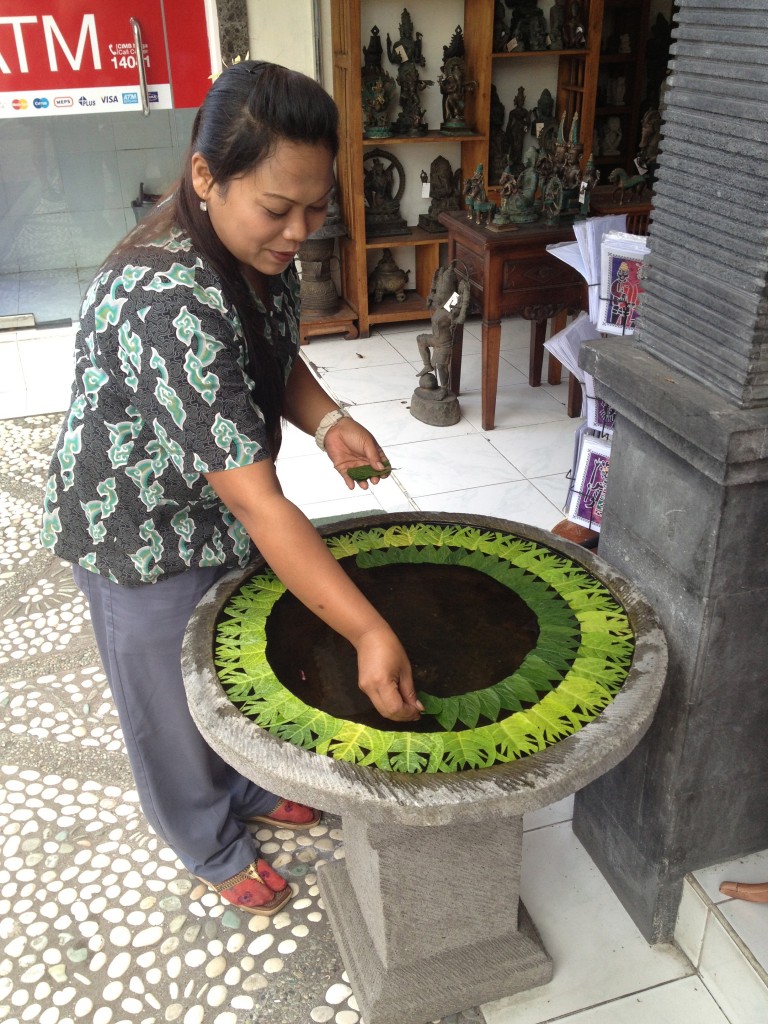
These were the raw materials she was working with:
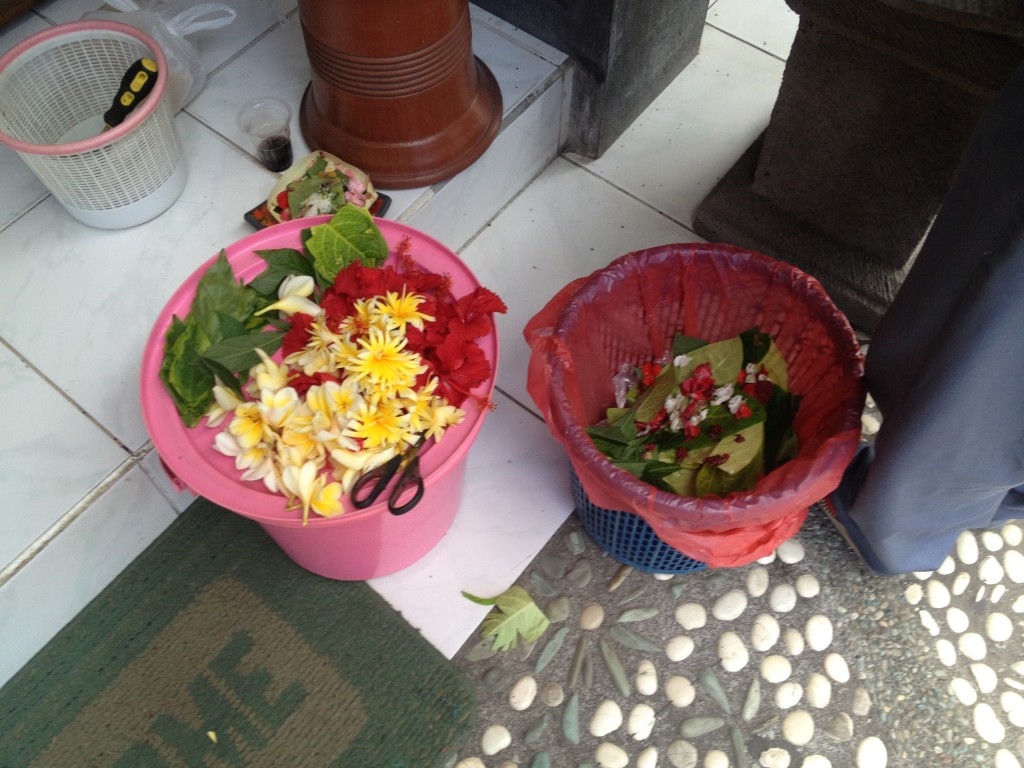
We stopped to watch her, and she said it was okay for me to take pictures. We stood deep engrossed in her precise and beautiful work for the next half hour. After these two layers of greens:
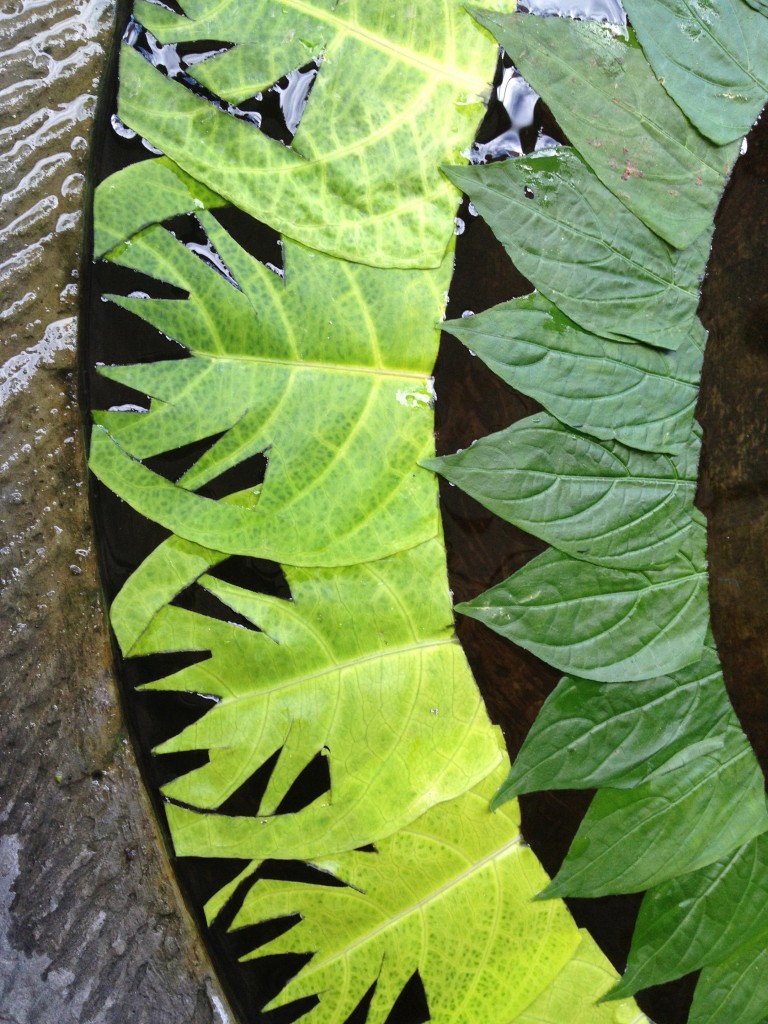
…she added two rows of hibiscus. Each row slightly overlapped the one before. She wet each hibiscus blossom in the water, using the moisture as glue to stick each new blossom to the pre-existing outside row. As she worked, we struck up a conversation. I asked her, “Do you try to be in a particular frame of mind when you do this? Or do you think about your day and your worries?”
“Nothing special,” she replied in English.
“Is this a prayer for you or just a job?”
“Just a job,” she said.
At one point, she left the flower arranging to wait on a customer and then returned to the flowers.
“Do you make the same pattern every day?” I asked.
“No,” she said, “Different.” Aju began rolling each frangipani blossom into a tight roll and then cutting it with a scissor, just as we do when making snowflakes out of folded square of white paper. Then she fluffed out each blossom, revealing its new perfectly shredded edges. Then Aju took a hibiscus stamen carefully placed it in the center of each altered frangipani. Then she floated the finish product one carefully in the water, placing it just so. The result looked like this:

I felt peaceful just watching her work. As I waited to see what she’d put in the center of her design, a hugely pregnant woman walked by, cradling her motorcycle helmet like a baby.
After Ayu placed the final flower in the center, she began adding tiny accent flowers all around the edges. “Wow,” said Karyn, “it looks like a kaleidoscope.”
“It looks like a mandala,” I said.
Here’s the finished design:
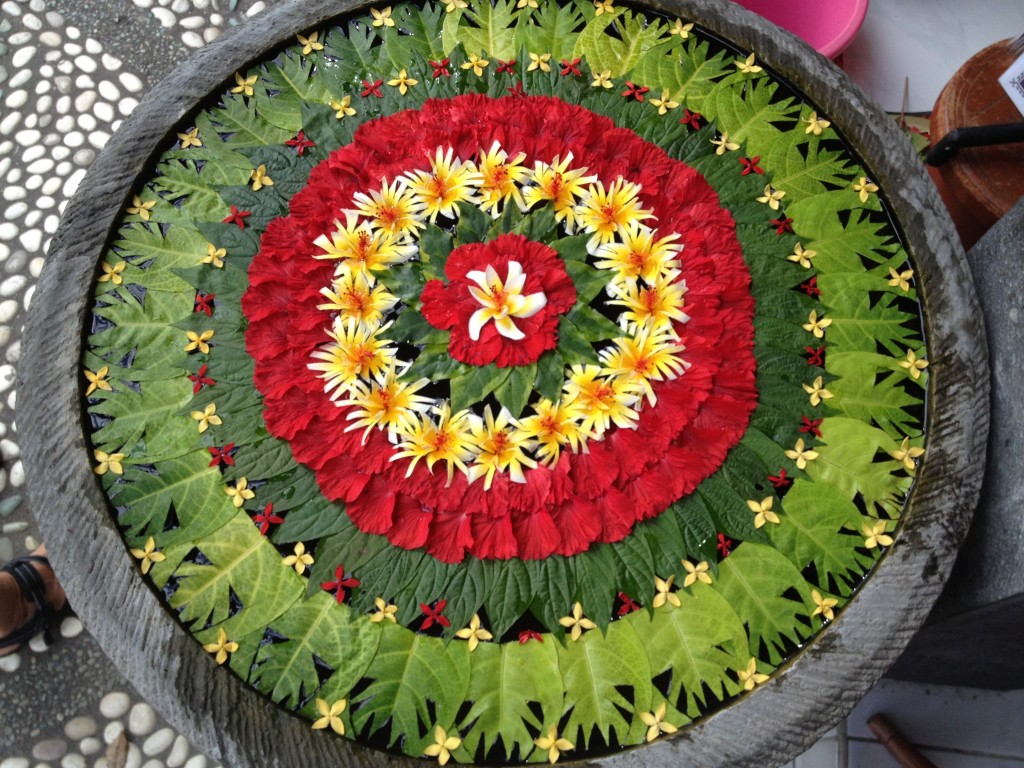
Ayu stood up painfully. We could see that her back hurt after bending over for such a long time. “I’m a yoga teacher,” Karyn said, “I can help you feel better.” And with Ayu’s permission, Karyn adjusted her back, right then and there.
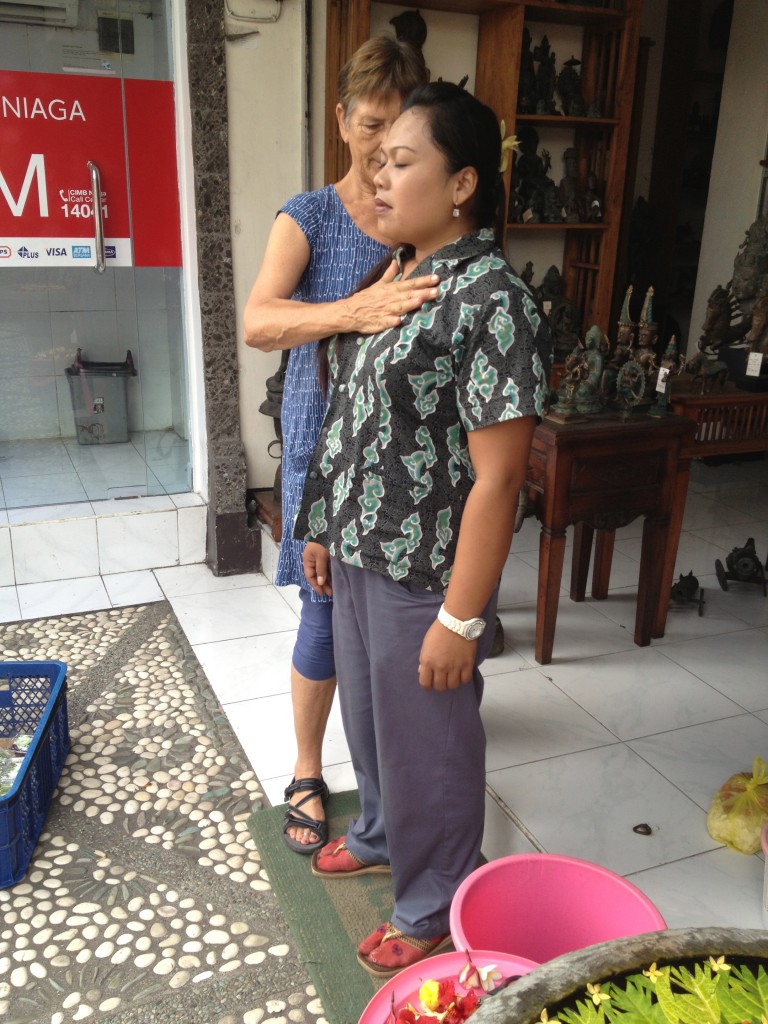
As Ayu worked, Karyn had been browsing through the statues. She knew she wanted to buy a stone Ganesh statue for the yurt in our backyard where she practices yoga and teaches private students. There were quite a few possible statues in Ayu’s shop. Karyn asked, “When there’s a price tag, does that mean there’s a fixed price or can I bargain?”
Ayu laughed, “Oh, you can bargain.”
We said we’d come back another day—maybe early in the morning so we could get the morning price.
Leaving the store, we continued down the sidewalk toward our hotel and the museum. Walking down the street in these touristy parts of Ubud means having someone call out, “Taxi?” every minute or so. And when you say, “No thank you,” whether in Indonesian or English, the next line is always, “Tomorrow?”
That’s your cue to laugh and walk away, and usually they laugh, too. It’s always light-hearted camaraderie between the hawkers and the tourists if you want it to be. But you have to get serious about where you’re walking all the time, because the sidewalks often look like this:
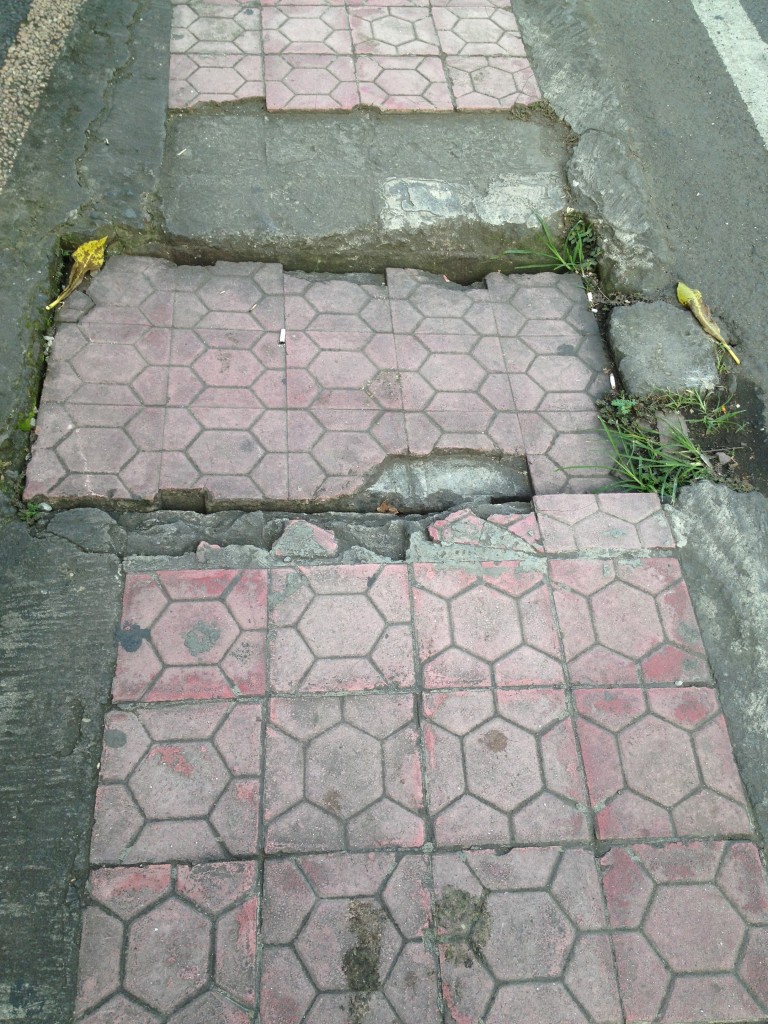
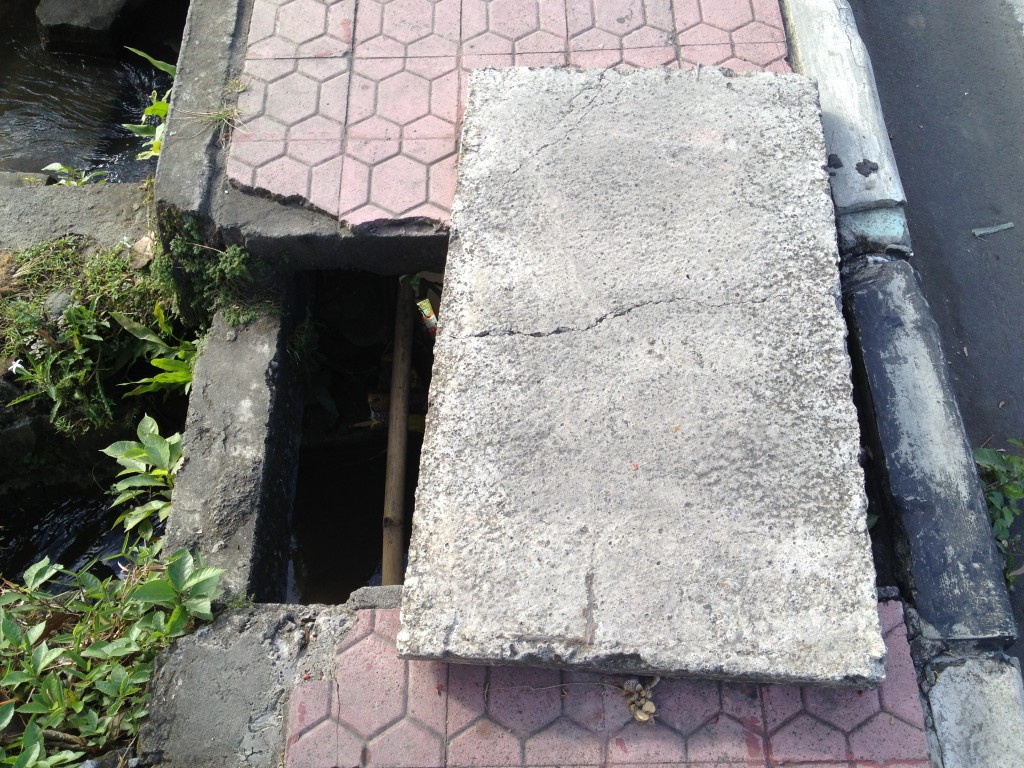
Karyn and I hadn’t really intended to shop—in fact, we discussed how we were shopped out from last year and were so relieved we wouldn’t get caught in the shopping frenzy that often overtakes first time visitors to Ubud. But then we passed a couple of kite stores and Karyn said she wanted to get a kite for our grandson, Lucas, and so we looked in that store and then saw a nicer one across the street, so we crossed the street and bargained for a kite. And next door? Well, there were the cutest Indonesian baby clothes and we have a new grandchild coming in August, less than two months from now, so we bargained for things for the new baby.
I felt so happy in the heat with Karyn—the day gay marriage finally cracked through the barrier and became real in our lifetime there we were, enjoying each other and shopping for gifts for our grandchildren in Bali. We couldn’t be on the streets in DC or San Francisco or Seattle or New York, or even in Santa Cruz, but we were shopping together in Ubud for our grandkids, and then we had our toes done (the best pedicure in the world was not an understatement), but that will have to be a story for another day.
My feet, though, felt as new and renewed as if I were a baby. I’ve never had a pedicure remotely like this one. And My toes looked pretty good too:
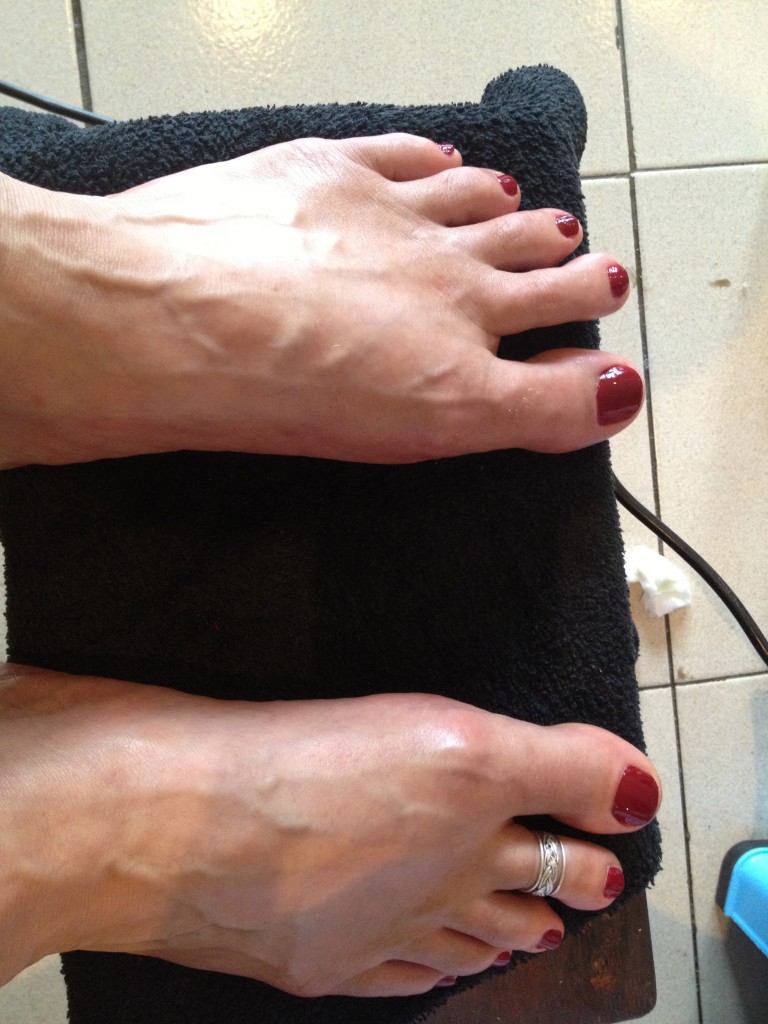
There was so much more to our day after we had our feet done. We had massages side by side, and came out looking just as relaxed as Larae did after her massage:
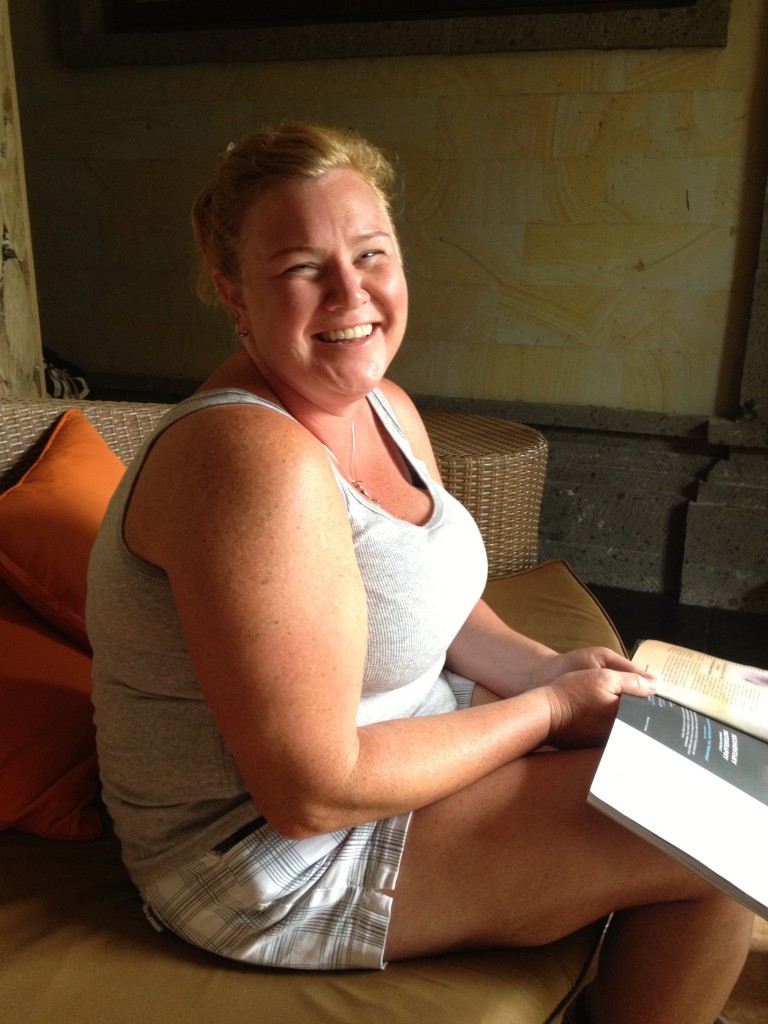
We had a great lunch (a salad, finally a real salad, with tahini dressing no less!), a dip in our pool in the heat of the day, Karyn’s restorative yoga class, a wonderful talk on (and demonstration of) Balinese dance by Surya, who among his many talents is a master dancer and dance teacher.
After his talk, five of us, who still had some energy left, braved a drizzly night to see an incredible children’s dance performance outdoors in a gorgeous setting—and then went out to dinner for Thai food. We got caught in a deluge on the way home (basically across the street and down a block from our hotel) and I’m sitting in my soggy sundress, happy, filled to the brim, and ready for bed and hopefully a long, restful sleep—but wanting to finish this post for you. (As you can tell, we never made it to the art museum).
P.S. We just got an email from Lizzy in Marrakesh to us in Bali congratulating us, her Moms, on our newly re-established right to marry! How’s that for international communication?
